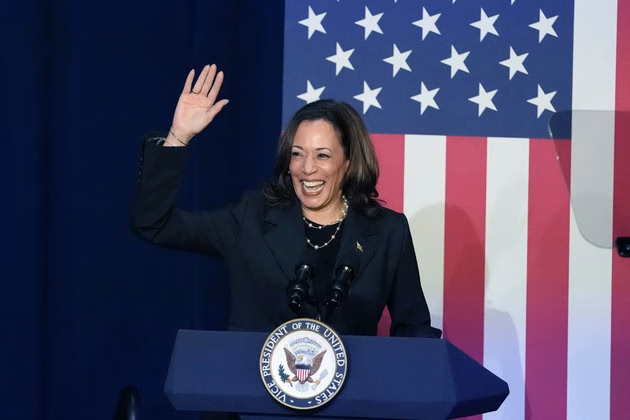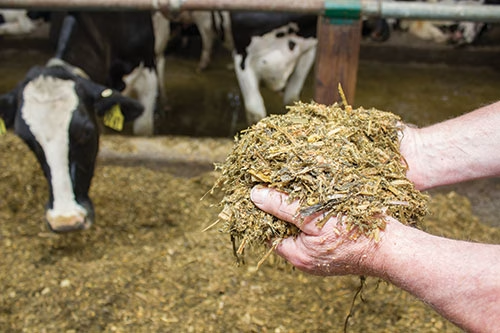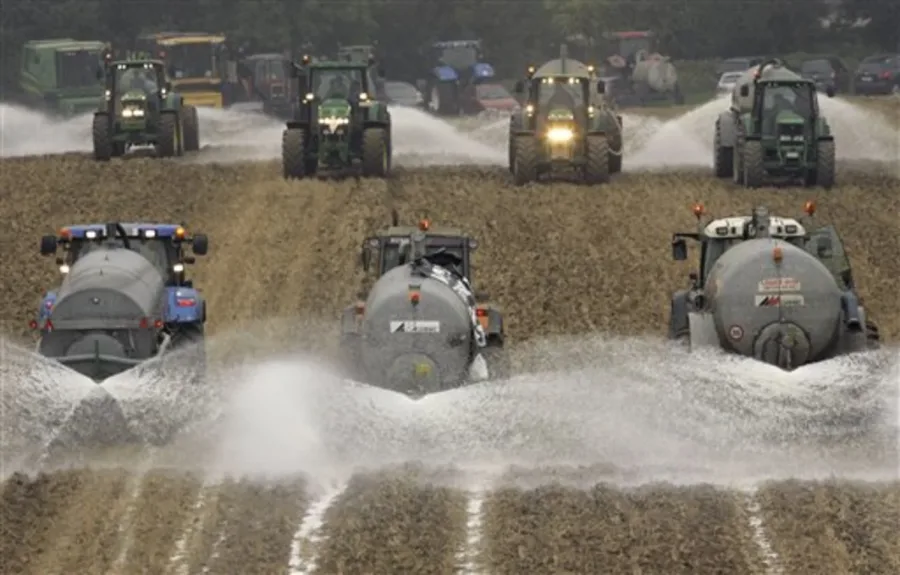Explore what Kamala Harris as President could mean for US dairy farmers. How will her background and stance on agriculture impact the dairy industry? Find out now.

The political landscape in the United States is about to change radically as President Biden steps down and Vice President Kamala Harris becomes the Democratic candidate. This revelation has ramifications for the nation’s dairy producers. To understand Harris’ possible influence on the dairy business, it’s necessary to look at her history, agricultural attitude, and particular measures she may support. Dairy producers are already dealing with market volatility and environmental requirements. Now, they face the extra uncertainty of a prospective new government. Understanding Harris’ agriculture policy is critical to planning for these possible changes.
From Civil Rights to the Senate: The Formative Journey of Kamala Harris
Kamala Harris was born in Oakland, California, on October 20, 1964. She grew up with a solid connection to the civil rights movement, inspired by her mother, Shyamala Gopalan, an Indian cancer researcher, and her father, Donald Harris, a Jamaican economist. She graduated from Howard University with a bachelor’s degree in political science and economics before receiving her J.D. at the University of California, Hastings College of the Law.
Harris started her career as a deputy district attorney in Alameda County, where she handled cases including sexual assault, burglary, and murder. Her creative approach led her to become San Francisco’s District Attorney in 2004, where she prioritized minimizing recidivism and combating crime with a combination of severity and compassion.
Harris made history in 2010 by becoming the first woman and person of color elected as California Attorney General. She addressed topics such as the mortgage crisis, which resulted in a $20 billion settlement for homeowners. She fought for criminal justice reforms, including prisoner release programs. In 2016, she was elected to the United States Senate, where she sat on critical committees such as the Judiciary, Intelligence, and Homeland Security, demonstrating her prosecutorial abilities and dedication to progressive issues.
In 2021, Harris became the United States’ first female, Black, and South Asian Vice President, adding to her impressive record of accomplishments.
Kamala Harris: A Legacy of Progressivism, Equity, and Inclusive Leadership
Notable accomplishments and a commitment to progressive ideas mark Kamala Harris’ political career. From 2011 to 2017, she served as California’s Attorney General, advocating for criminal justice reform, particularly the “Open Justice” data effort to increase openness. Harris has been a strong supporter of healthcare reform in the United States Senate, co-sponsoring Medicare for All while simultaneously addressing systematic racism, notably in police. Harris has often emphasized the significance of climate change, co-sponsoring the Green New Deal, which promotes sustainable development and environmental justice.
Harris campaigns for economic justice, accessible education, and the protection of underprivileged people. She ardently advocates women’s rights, equal pay, and reproductive rights. Her legislative work includes the Maternity CARE Act, which addresses maternity health inequities, particularly among Black women. She also supports comprehensive immigration reform, calling for compassionate treatment and avenues to citizenship.
Harris’s political career has included several progressive proposals emphasizing justice and sustainability. Her campaigning and legislative achievements reflect a leader dedicated to making society more open and egalitarian.
Kamala Harris’s Stance on Agricultural Issues Reflects a Commitment to Sustainability, Equity, and Innovation
Kamala Harris’s approach to agricultural problems demonstrates her dedication to sustainability, equality, and innovation. Her Senate voting record shows support for climate change legislation, which indirectly assists agriculture by encouraging sustainable agricultural techniques. She has supported measures to limit carbon emissions and promote renewable energy, critical to agriculture’s long-term survival.
Harris has stressed the preservation of small farms and the proper treatment of agricultural workers, fighting for fair salaries, safe working conditions, and immigration options for illegal workers. She co-sponsored the Climate Equity Act, which provides resources to underserved rural agricultural communities confronting environmental deterioration. She backed the Agriculture Resilience Act, which provides government assistance for small processing facilities and improves market access and resilience.
Her proactive strategy includes forming a strike team to expedite access to agricultural programs and eliminate bureaucratic bottlenecks. Thus, Harris’ initiatives position her as an advocate of sustainable, egalitarian, and creative agriculture policy.
For Dairy Farmers, Kamala Harris Offers a Blueprint for Sustainable Transition
Vice President Kamala Harris has yet to be particularly outspoken on dairy-related problems. Still, her agriculture policies imply a balanced approach emphasizing sustainability and economic viability. Harris’s emphasis on environmental care may cause issues for dairy producers, notably methane emissions and water consumption. However, her support for innovation and technical developments provides an opportunity to modernize dairy methods, inspiring a new era of sustainable dairy production.
Harris has called for stringent climate action, impacting behaviors such as methane emissions from livestock. During her Senate career, she supported sustainable agricultural policies that indirectly affected the dairy business. Her support shows her commitment to animal welfare and farm sustainability for legislation that reduces the environmental effect of large-scale animal farming, as well as financial incentives for environmentally friendly methods.
Harris’ approach promotes sustainable dairy production practices. This proposes a transition time during which eco-friendly actions may be encouraged rather than imposed. Dairy producers may benefit from funding programs that promote agricultural innovation, alleviating the financial burden of the changeover and providing reassurance about the economic viability of the industry.
Potential Policies Under a Harris Administration: Aligning Economic Viability with Environmental Responsibility
Kamala Harris has always championed measures that balance economic viability and environmental sustainability. Her presidency might bring about significant changes for dairy producers.
Subsidies: Harris may argue for reformed agricultural subsidies to benefit small and medium-sized farmers, including dairy producers. These incentives would promote environmentally friendly techniques that cut greenhouse gas emissions from dairy farms, potentially reducing costs and increasing profitability for these producers.
Environmental rules: Given her strong position on climate change, she may impose harsher rules on methane emissions and water consumption in the dairy industry, promoting environmentally friendly technology like methane digesters.
Trade: Harris favors fair trade procedures to protect American farmers from unfair foreign competition. He may advocate for trade deals that improve market access for U.S. dairy while assuring higher import requirements.
Labor: As an advocate for workers’ rights, Harris may concentrate on improving conditions in the dairy industry, which depends mainly on foreign labor. This might involve establishing routes to citizenship, increasing pay and working conditions, solving labor shortages, and making agriculture a more viable career option.
A Harris administration might use these measures to steer the dairy sector toward sustainability and justice, addressing both environmental and economic concerns while increasing the well-being of workers and small farms. This could potentially lead to a more prosperous and equitable dairy industry.
Anticipating Kamala Harris’s Impact on Dairy Farming: A Multifaceted Approach to Economic, Environmental, and Social Reform
Kamala Harris’ attitude on agricultural concerns, which focuses on sustainability and equality, foreshadows prospective changes for U.S. dairy producers, including economic, environmental, and social considerations. Economically, her campaign for sustainable practices may need significant investment in eco-friendly technology and adherence to stringent standards among dairy producers. While these measures may incur extra expenses, they may also provide long-term economic gains by accessing new markets and winning government incentives.
Environmentally, Harris’ proposals may force changes in agricultural techniques to decrease greenhouse gas emissions and encourage sustainable energy. Dairy producers may need to utilize regenerative practices, better waste management, and more renewable energy. While initially tricky, these modifications may help reduce the environmental effects of dairy production and prevent climate change.
Socially, Harris’ dedication to fairness may result in better labor standards in the dairy business, as he advocates for better working conditions, fair salaries, and greater farm worker rights. Although these enhancements may raise labor costs, they may improve livelihoods.
The Harris administration might also provide dairy producers incentives and subsidies to help them shift to more sustainable techniques. Dairy producers could benefit from financial aid like the $32 million granted to meat and poultry processing plants.
A Harris presidency might improve U.S. dairy production by reconciling environmental stewardship with economic and social justice. Though these improvements may initially be costly, they offer a more sustainable, egalitarian, and resilient agriculture economy.
Uniting Behind Harris: Support from United Farm Wookers
United Farm Workers President Teresa Romero endorsed Vice President Kamala Harris as the ideal leader to continue the transformative work of the Biden-Harris administration. Romero highlighted the administration’s efforts to strengthen farm workers’ right to unionize, ensure undocumented essential workers received COVID vaccines and relief, raise wages, and propose federal standards to protect farm workers from extreme temperatures. Romero praised President Biden for his lifelong service and dedication to working Americans.
The Bottom Line
As Kamala Harris prepares to take office, the consequences for the U.S. dairy farming sector are significant. Harris’s experience and progressive agricultural attitudes indicate transformational possibilities. Her persistent dedication to sustainability and economic viability heralds a new age in dairy farming, offering a more equal and sustainable future. Dairy producers may expect additional financial assistance, better working conditions, and intense climate change policies under a Harris government. Harris’ agricultural reform strategy is broad and forward-thinking, emphasizing crucial problems, including COVID-19, racial fairness, and economic resiliency. He prioritizes scientific evidence.
Key Takeaways:
- A Legacy of Advocacy: Harris has a background rooted in civil rights and progressive leadership, promising a focus on equity and inclusion.
- Environmental Commitment: Harris emphasizes sustainability and innovation in her stance on agricultural issues, which could impact dairy farming practices.
- Economic Viability: She aims to align economic policies with environmental responsibilities, potentially offering support for sustainable farming transitions.
- Government Support: Potential policies under her administration could provide new pathways for economic support, focusing on both profitability and environmental stewardship.
- Industry-Specific Strategies: For dairy farmers, this might mean a shift towards more sustainable practices, possibly accompanied by federal incentives and support programs.
Summary:
Kamala Harris, the incoming U.S. Vice President, is a civil rights activist and political figure with a strong background in politics. Born in Oakland, California, in 1964, she graduated from Howard University with a bachelor’s degree in political science and economics before receiving her J.D. at the University of California, Hastings College of the Law. Harris became the first woman and person of color elected as California Attorney General in 2010, addressing issues like the mortgage crisis and criminal justice reforms. She was elected to the United States Senate in 2016, where she served on critical committees. In 2021, she became the first female, Black, and South Asian Vice President. Harris’s political career has focused on justice and sustainability, particularly in agriculture. She supports climate change legislation, renewable energy, and fair treatment of agricultural workers. Harris co-sponsored the Climate Equity Act and the Agriculture Resilience Act, providing resources to underserved rural agricultural communities. She also promotes sustainable dairy production practices, proposing a transition time for eco-friendly actions.













